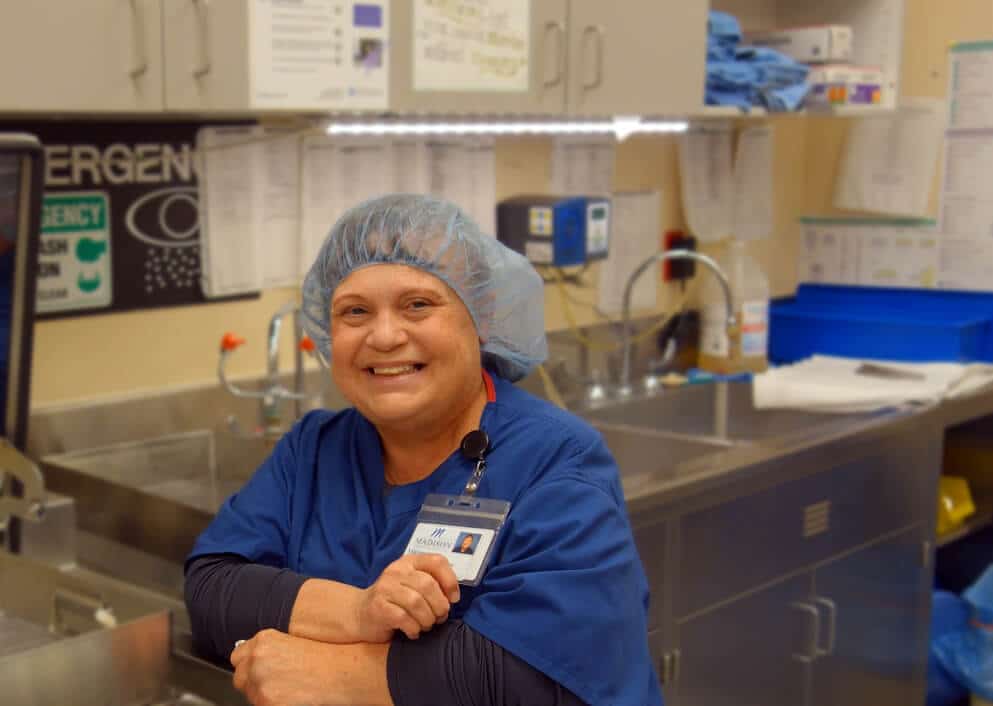Eliminating the “Bad Guys” with Central Sterile Supervisor Margaret Wood
Eliminating the “Bad Guys” with Central Sterile Supervisor Margaret Wood

Story and Photo by Jeremiah Kalb
Each year in the United States, there are approximately 53 million outpatient surgical procedures and 46 million inpatient surgical procedures.
All of these procedures introduce a significant risk to the patient – infection.
Bacteria like Staphylococcus, Streptococcus, and Pseudomonas left on surgical instruments can infect the surgical site and lead to patients becoming gravely ill and requiring further medical attention following surgery.
If surgical instruments are not sterile, this may also mean spreading serious illnesses or diseases such as HIV/AIDs, Hepatitis, and more.
Central Sterile Processing Supervisor Margaret Wood’s job is to lead a mighty team of three technicians that help eliminate all pathogenic microorganisms.
Sterilization ensures that infectious pathogens do not transfer to the patient.
“Because of our work, patients can safely undergo surgery,” Wood explains.
She sees Central Sterile as a critical part of the hospital’s backbone.
It’s safe to say that patient safety begins in the Central Sterile Processing department, and the rest of the hospital would not be able to function without them.
Central Sterile Processing is the hospital area where cleaning, decontamination, inspection, assembly, packaging, storage, and distribution of instruments, equipment, and supplies takes place.
Wood, a 22-year veteran of sterile processing, runs the day-to-day operations for the department.
Her team handles upwards of 900 instrument sets each month.
Despite high productivity pressures, a total joint replacement alone can have anywhere between six and eight trays, and Wood’s team did 286 of these last year; they take pride in their work.
The mission is singular yet complex: to safeguard patients from infections.
“Behind every instrument, there’s a patient, and so we’re patient advocates,” she says.
Attention to detail is an absolute must every minute of every day for Wood and her team.
“We want to make sure every instrument in that set, whether it be ten or whether it be 100, is what’s supposed to be in that tray and is working properly,” Wood says.
Strict adherence to the “process” is imperative even when a surgeon drops an instrument and needs it back ASAP.
“You’re going to be waiting 25-30 minutes to get it back,” Wood says. “We try to have backups for things that could be dropped, but sometimes we just don’t.”
While a surgeon might expect the instrument back immediately, there’s no room for cutting corners.
“If that was your mother, your sister, your husband or wife, or child, would you want us to do it halfway, or would you want us to do it the proper way?” Wood asks.
The proper way includes hand washing and machine cleaning at 180 degrees. Instruments are then put through Steam, Parasitic Acid, or Hydrogen Peroxide sterilization.
Several types of test indicators are used to monitor whether the necessary conditions were met to kill a specified number of microorganisms for a given sterilization process.
“Having all these checks makes it so we as sterile processing people and the nurses and techs in the room know they can safely use these instruments,” she says.
There is much to be said about the thought and effort that goes into Wood’s carefully wrapped blue packages.
